Research News & Highlights
ALMA's view of the M-dwarf GSC 07396-00759's edge-on debris disc: AU Mic's coeval twin
Patrick F. Cronin-Coltsmann, Grant M. Kennedy, Christian Adam, Quentin Kral, Jean-François Lestrade, Sebastian Marino, Luca Matrà, Simon J. Murphy, Johan Olofsson, Mark C. Wyatt
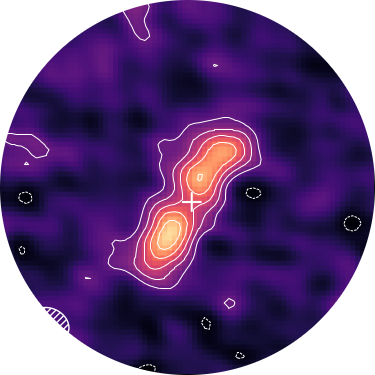
We present new ALMA Band 7 observations of the edge-on debris disc around the M1V star GSC 07396-00759. At ~20 Myr old and in the beta Pictoris Moving Group along with AU Mic, GSC 07396-00759 joins it in the handful of low mass M-dwarf discs to be resolved in the sub-mm. With previous VLT/SPHERE scattered light observations we present a multi-wavelength view of the dust distribution within the system under the effects of stellar wind forces. We find the mm dust grains to be well described by a Gaussian torus at 70 au with a FWHM of 48 au and we do not detect the presence of CO in the system. Our ALMA model radius is significantly smaller than the radius derived from polarimetric scattered light observations, implying complex behaviour in the scattering phase function. The brightness asymmetry in the disc observed in scattered light is not recovered in the ALMA observations, implying that the physical mechanism only affects smaller grain sizes. High resolution follow-up observations of the system would allow investigation into its unique dust features as well as provide a true coeval comparison for its smaller sibling AU Mic, singularly well observed amongst M-dwarfs systems.
Warping Away Gravitational Instabilities in Protoplanetary Discs
Sahl Rowther, Rebecca Nealon, Farzana Meru
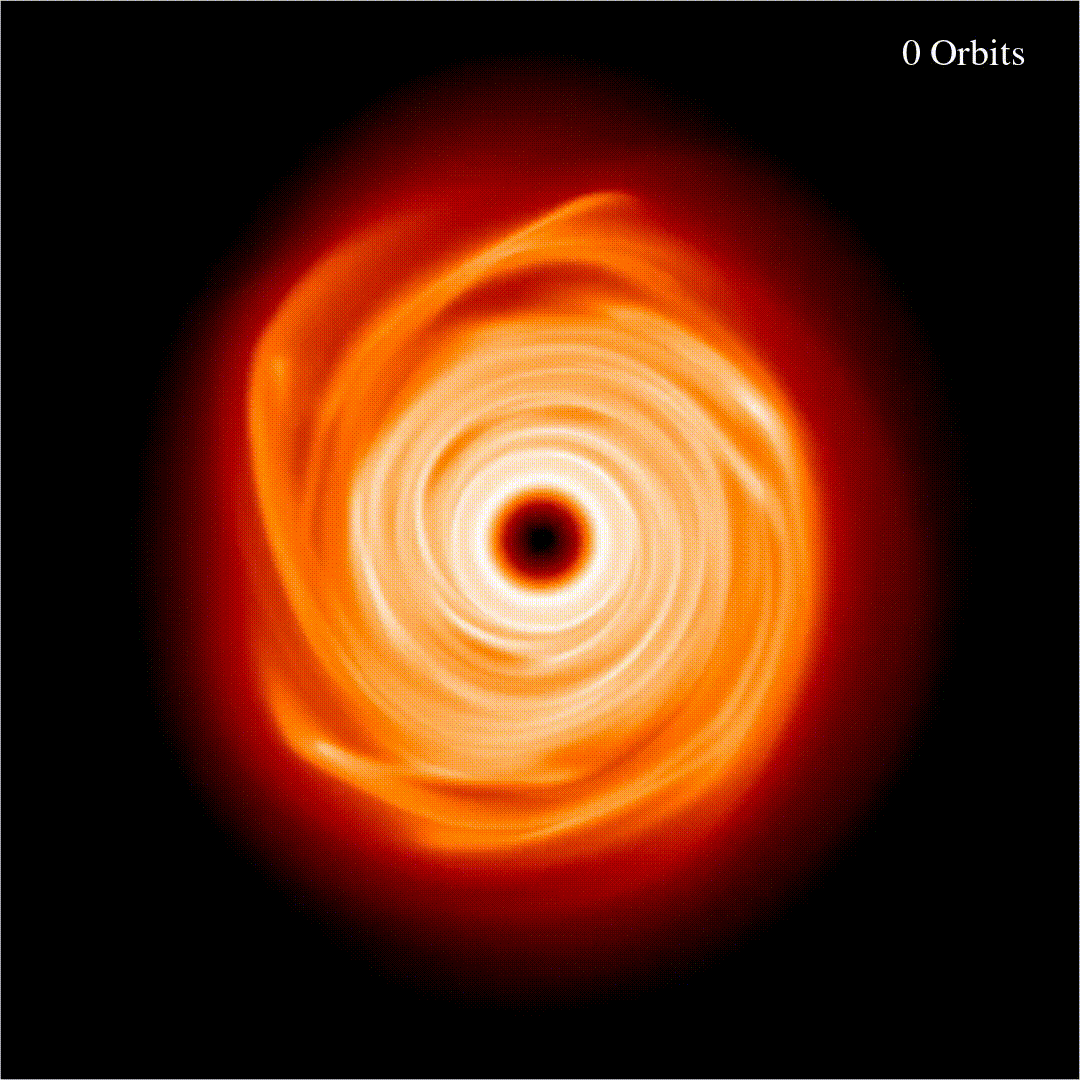
We perform 3D SPH simulations of warped, non-coplanar gravitationally unstable discs to show that as the warp propagates through the self-gravitating disc, it heats up the disc rendering it gravitationally stable. Thus losing their spiral structure and appearing completely axisymmetric. In their youth, protoplanetary discs are expected to be massive and self-gravitating, which results in non-axisymmetric spiral structures. However recent observations of young protoplanetary discs with ALMA have revealed that discs with large-scale spiral structure are rarely observed in the midplane. Instead, axisymmetric discs with some also having ring & gap structures are more commonly observed. Our work involving warps, non-coplanar disc structures that are expected to commonly occur in young discs, potentially resolves this discrepancy between observations and theoretical predictions. We demonstrate that they are able to suppress the large-scale spiral structure of self-gravitating protoplanetary discs.
Orbit decay of 2-100 au planetary remnants around white dwarfs with no gravitational assistance from planets
Dimitri Veras, Yusuf Birader, Uwais Zaman
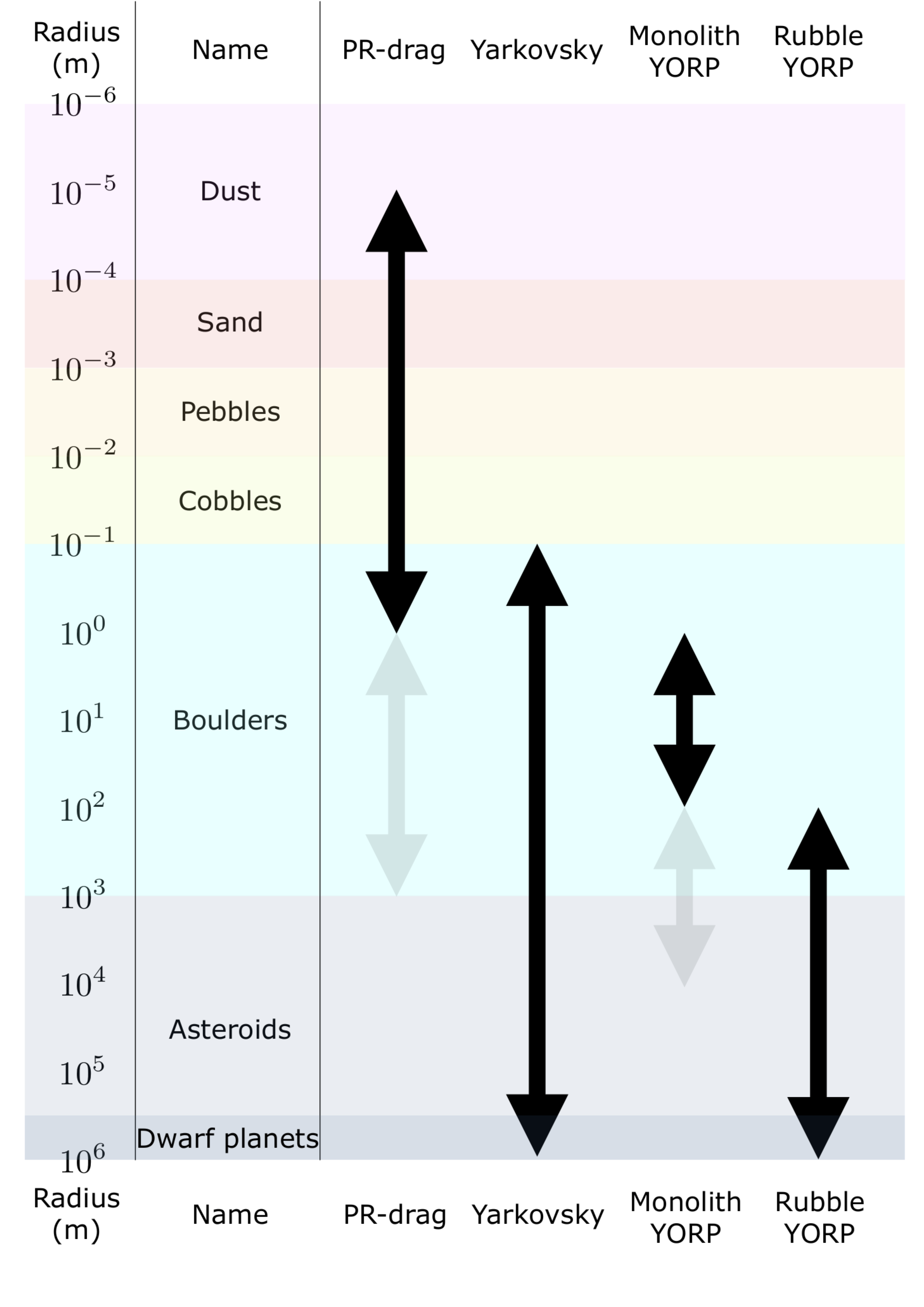
Debris discs orbiting white dwarfs are the primary conduit though which planetary remnants accrete onto the photosphere. A widely-held assumption is that these discs are formed by the destruction of asteroids flung towards the white dwarf by a terrestrial or giant planet. However, these planets could have been previously been engulfed by the star or escaped the system, leaving behind asteroids, boulders, cobbles, pebbles, sand and dust. These remaining small bodies could then persist throughout the host star's evolution into a white dwarf at ~2-100 au scales, and then be radiatively dragged towards the white dwarf to create the disc without the help of a planet. Here we identify the parameter space and cooling ages for which this one metal-pollution mechanism is feasible by, for the first time, coupling Poynting-Robertson drag, the Yarkovsky effect and the YORP effect solely from rapidly dimming white dwarf radiation (see figure). We find that this no-planet pollution scenario is efficient for remnant 10^-5-10^-4 m dust up to about 80 au, 10-4-10-3 m sand up to about 25 au and 10^-3-10^-2 m small pebbles up to about 8 au, and perhaps 10^-1-10^0 m small boulders up to tens of au. Further, young white dwarf radiation can spin up large strength-less boulders with radii 10^2-10^3 m to destruction, breaking them down into smaller fragments which then can be dragged towards the white dwarf. Our work hence introduces a planet-less metal-pollution mechanism that may be active in some fraction of white dwarf planetary systems..
Velocity-imaging the rapidly precessing planetary disc around the white dwarf HE 1349-2305 using Doppler tomography
Christopher J. Manser, Erik Dennihy, Boris T. Gänsicke, John H. Debes, Nicola P. Gentile Fusillo, J. J. Hermes, Mark Hollands, Paula Izquierdo, B. C. Kaiser, T. R. Marsh, Joshua S. Reding, Pablo Rodríguez-Gil, Dimitri Veras, David J. Wilson
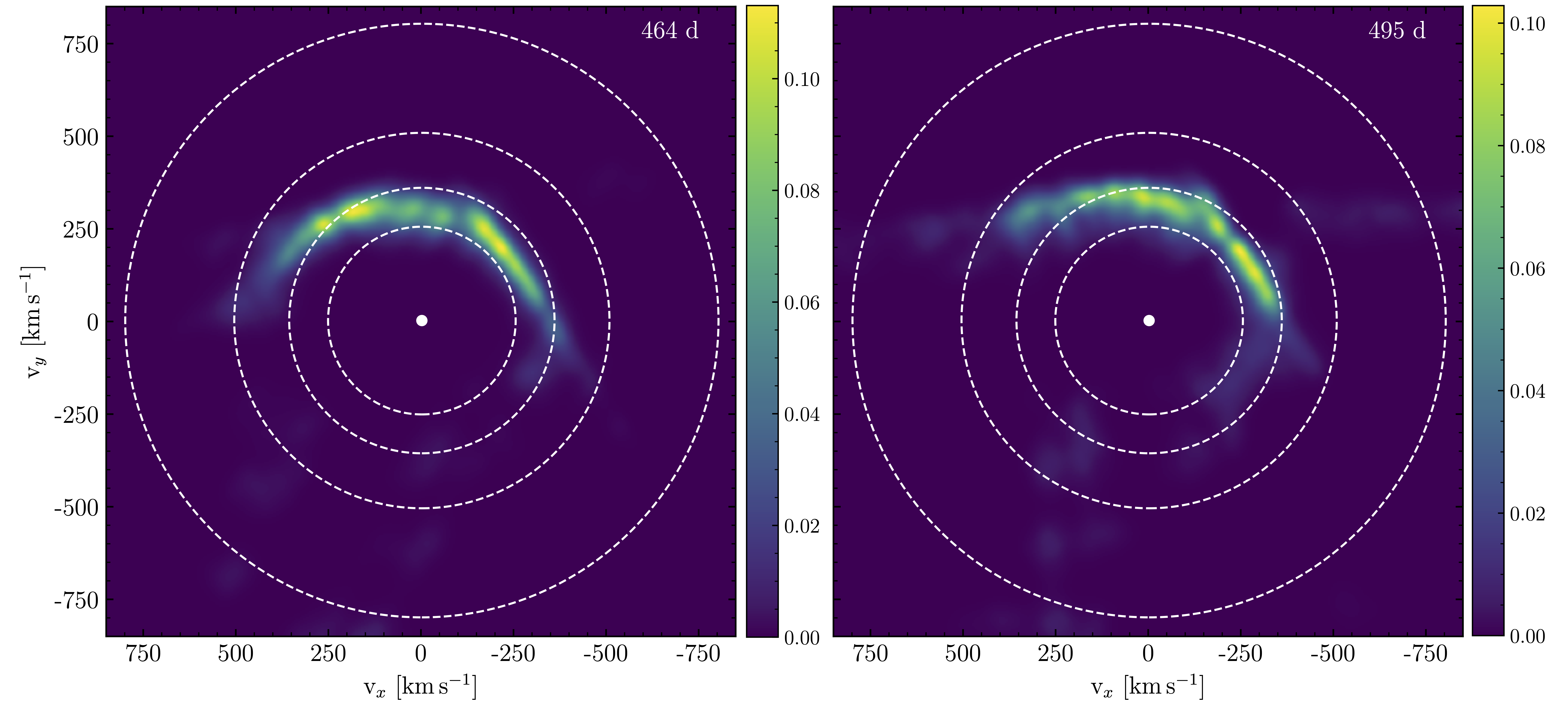
The presence of planetary material in white dwarf atmospheres, thought to be accreted from a dusty debris disc produced via the tidal disruption of a planetesimal, is common. Approximately five per cent of these discs host a co-orbital gaseous component detectable via emission from atomic transitions - usually the 8600 Angstrom CaII triplet. These emission profiles can be highly variable in both morphology and strength. Furthermore, the morphological variations in a few systems have been shown to be periodic, likely produced by an apsidally precessing asymmetric disc. Of the known gaseous debris discs, that around HE1349-2305 has the most rapidly evolving emission line morphology, and we present updated spectroscopy of the CaII triplet of this system. The additional observations show that the emission line morphologies vary periodically and consistently, and we constrain the period to two aliases of 459±3d and 502±3d. We produce images of the CaII triplet emission from the disc in velocity space using Doppler tomography - only the second such imaging of a white dwarf debris disc. We suggest that the asymmetric nature of these velocity images is generated by gas moving on eccentric orbits with radially-dependent excitation conditions via photo-ionisation from the white dwarf. We also obtained short-cadence (~ 4 min) spectroscopy to search for variability on the time-scale of the disc's orbital period (~ hours) due to the presence of a planetesimal, and rule out variability at a level of ~ 1.4 per cent.
White dwarf planetary debris dependence on physical structure distributions within asteroid belts
Catriona H. McDonald, Dimitri Veras
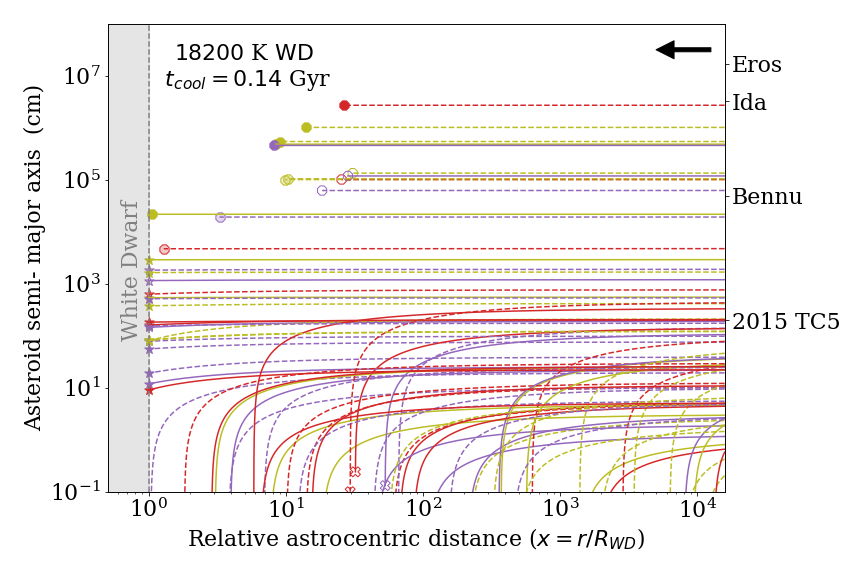
White dwarfs which exhibit transit signatures of planetary debris and accreted planetary material provide exceptional opportunities to probe the material composition and dynamical structure of planetary systems. Although previous theoretical work investigating the role of minor body disruption around white dwarfs has focussed on spherical bodies, Solar System asteroids can be more accurately modelled as triaxial ellipsoids. Here we present an analytical framework to identify the type of disruption (tidal fragmentation, total sublimation or direct impact) experienced by triaxial asteroids approaching white dwarfs on extremely eccentric (e ~ 1) orbits. This framework is then used to identify the outcomes for simplified Main belt analogues of 100 bodies across five different white dwarf temperatures. We also present an empirical relationship between cooling age and effective temperature for both DA and DB white dwarfs to identify the age of the white dwarfs considered here. We find that using a purely spherical shape model can underestimate the physical size and radial distance at which an asteroid is subjected to complete sublimation, and these differences increase with greater elongation of the body. Contrastingly, fragmentation always occurs in the largest semi-axis of a body and so can be modelled by a sphere of that radius. Both fragmentation and sublimation are greatly affected by the body's material composition, and hence by the composition of their progenitor asteroid belts. The white dwarf temperature, and hence cooling age, can affect the expected debris distribution: higher temperatures sublimate large elongated asteroids, and cooler temperatures accommodate more direct impacts.
A review: planetary systems around white dwarfs
Dimitri Veras
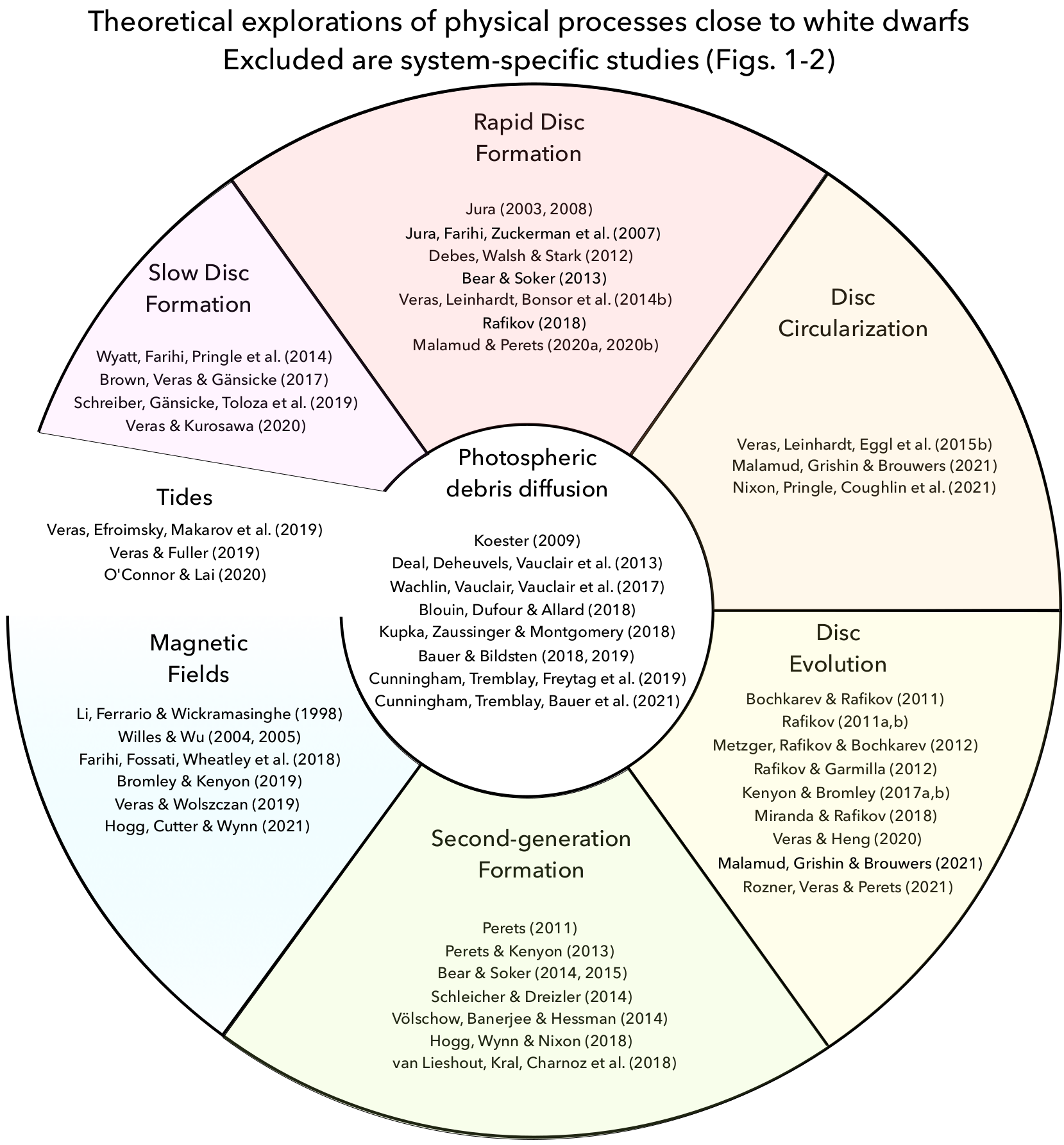
White dwarf planetary science is a rapidly growing field of research featuring a diverse set of observations and theoretical explorations. Giant planets, minor planets, and debris discs have all been detected orbiting white dwarfs. The innards of broken-up minor planets are measured on an element-by-element basis, providing a unique probe of exoplanetary chemistry. Numerical simulations and analytical investigations trace the violent physical and dynamical history of these systems from au-scale distances to the immediate vicinity of the white dwarf, where minor planets are broken down into dust and gas and are accreted onto the white dwarf photosphere. Current and upcoming ground-based and space-based instruments are likely to further accelerate the pace of discoveries.
The post-main-sequence fate of the HR 8799 planetary system
Dimitri Veras, Sasha Hinkley
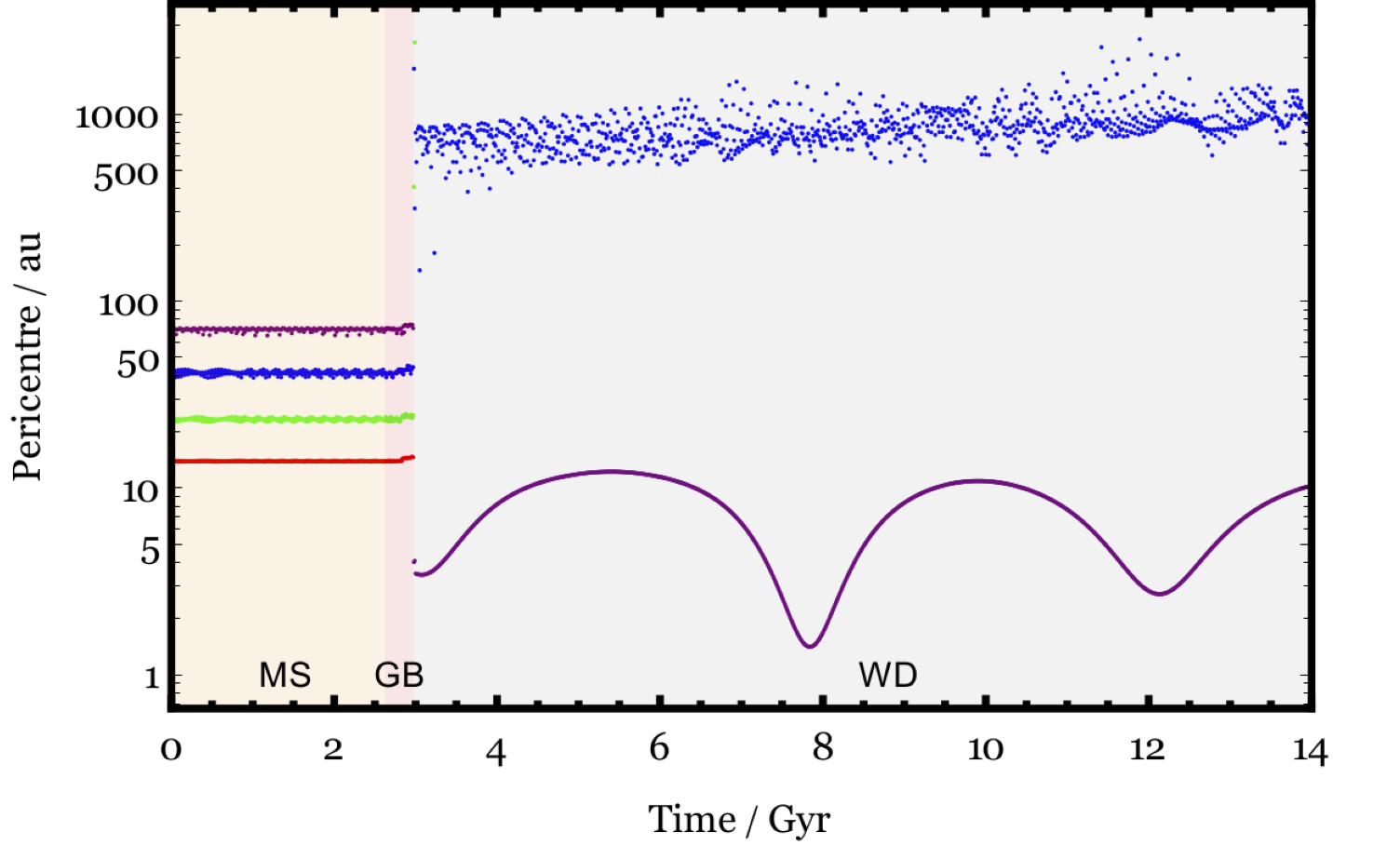
The noteworthy four-planet HR 8799 system teeters on the brink of gravitational instability and contains an A-type host star which is characteristic of the progenitors of the majority of known white dwarf planetary system hosts. Gozdziewski and Migaszewski (2020) have demonstrated that the system can retain all four planets for at least 1 Gyr along the main sequence if the planets evolve within an externally unperturbed 8:4:2:1 mean motion resonance configuration. Here we propagate forward their most stable fit beyond the main sequence, and incorporate external effects from Galactic tides and stellar flybys. We find that (i) giant branch mass loss always breaks the resonance, and usually triggers the ejection of two of the planets, (ii) stellar flybys and Galactic tides rarely break the resonance during the main-sequence and giant branch phases, but play a crucial role in determining the final planetary configurations around the eventual white dwarf host star, and (iii) the meanderings of the surviving planets vary significantly, occupying regions from under 1 au to thousands of au. The ubiquitous survival of at least one planet and the presence of the debris discs in the system should allow for dynamical pathways for the white dwarf to be metal-polluted.
ALMA imaging of the M-dwarf Fomalhaut C's debris disc
Patrick F. Cronin-Coltsmann, Grant M. Kennedy, Paul Kalas, Julien Milli, Cathie J. Clarke, Gaspard Duchêne, Jane Greaves, Samantha M. Lawler, Jean-François Lestrade, Brenda C. Matthews, Andrew Shannon, Mark C. Wyatt
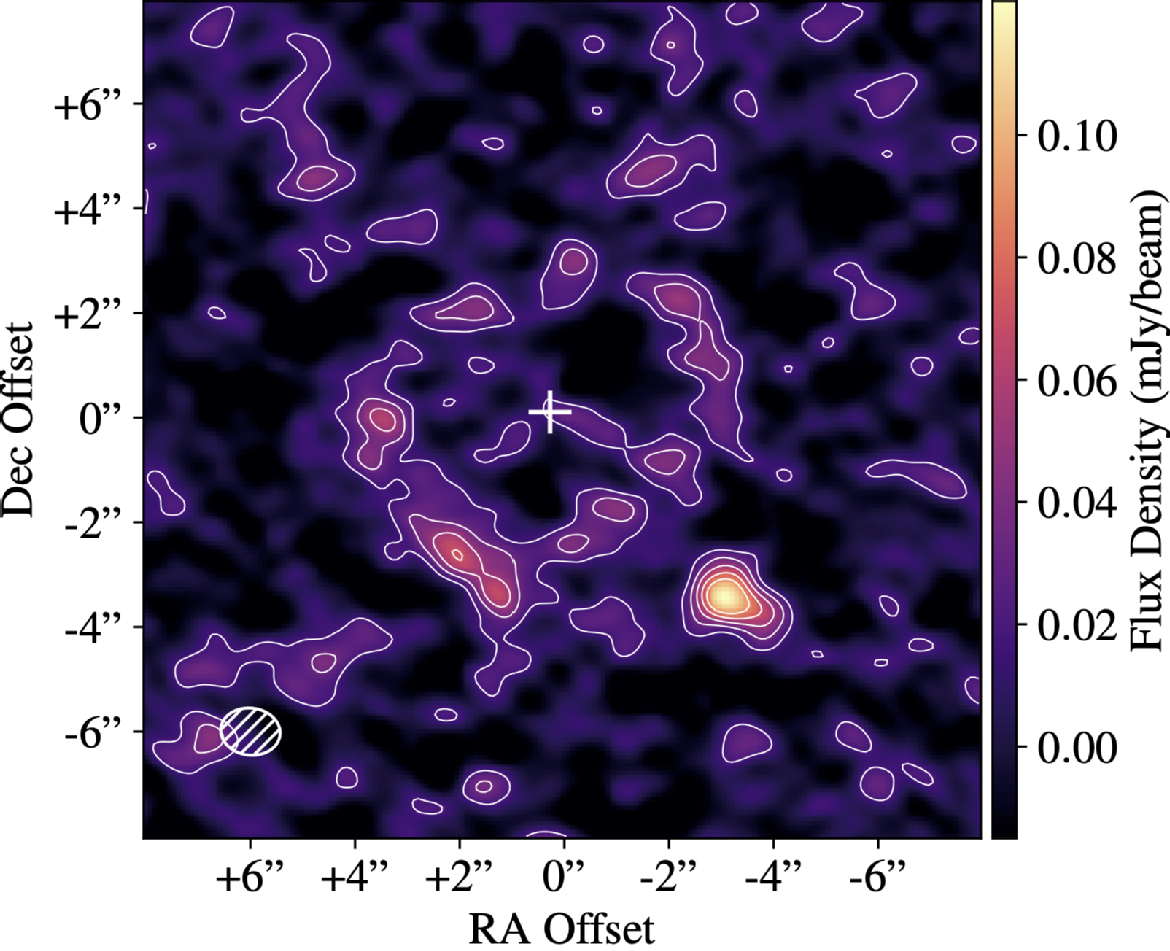
Fomalhaut C (LP 876-10) is a low mass M4V star in the intriguing Fomalhaut triple system and, like Fomalhaut A, possesses a debris disc. It is one of very few nearby M-dwarfs known to host a debris disc and of these has by far the lowest stellar mass. We present new resolved observations of the debris disc around Fomalhaut C with the Atacama Large Millimetre Array which allow us to model its properties and investigate the system's unique history. The ring has a radius of 26 au and a narrow full width at half maximum of at most 4.2 au. We find a 3σ upper limit on the eccentricity of 0.14, neither confirming nor ruling out previous dynamic interactions with Fomalhaut A that could have affected Fomalhaut C's disc. We detect no 12CO J=3-2 emission in the system and do not detect the disc in scattered light with HST/STIS or VLT/SPHERE. We find the original Herschel detection to be consistent with our ALMA model's radial size. We place the disc in the context of the wider debris disc population and find that its radius is as expected from previous disc radius-host luminosity trends. Higher signal-to-noise observations of the system would be required to further constrain the disc properties and provide further insight to the history of the Fomalhaut triple system as a whole.
UKEXOM 2021
Sahl Rowther -- Giant Planets Can Suppress Gravitational Instabilities In Protoplanetary Discs
The work covered in this talk is described in Rowther et al. 2020.
